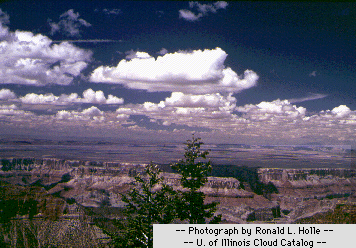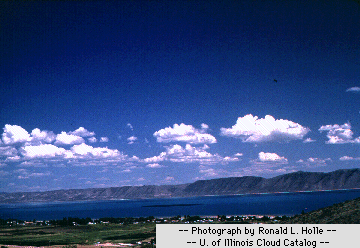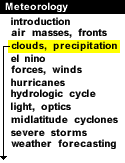
|
Probably the most familiar of the classifications is the cumulus cloud and the variety of shapes, sizes, and colors it attains. Generated most commonly through either thermal convection or frontal lifting, these clouds can grow to heights in excess of 39000 feet (12000 meters), releasing incredible amounts of energy by the condensation of water vapor within the cloud itself.
Fair weather cumulus have the appearance of floating cotton with a flat base and distinct outlines, and colors range from white to light gray. Fair weather cumulus have a lifetime of anywhere from 5-40 minutes and show only slight vertical growth, with the tops designating the limit of the rising air. Given suitable conditions, however, what may initially begin as harmless fair weather cumulus can later develop into towering cumulonimbus clouds associated with powerful thunderstorms.

Fair weather cumulus are fueled by
buoyant bubbles of air, or
thermals that rise
upwards from the earth's surface. As they rise, the
water vapor within cools
and condenses forming cloud
droplets. The location above the ground where this condensation process
takes place is called the
lifting condensation level
and is easily identified by the
distinctly flat cloud bases associated with fair weather cumulus.

In their early stages,
fair weather cumulus have sharply defined
bases while the edges of older clouds appear more ragged,
an artifact of cloud erosion. The
evaporation of
cloud edges cools the air surrounding the cloud, making it heavier,
resulting in sinking motion (or subsidence) outside the cloud.
The downward motion inhibits
further convection
and the growth of additional thermals from below, which is
why fair weather cumulus typically have expanses of clear sky between them.
Without a continued supply of rising air into the cloud, the erosion process
continues, eventually resulting in the cloud's eventual dissipation.
|




